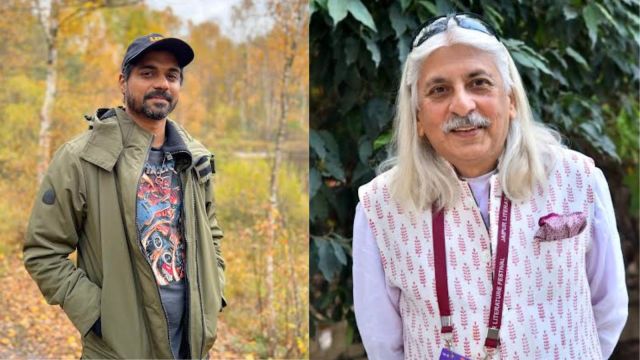Fleeing Delhi pollution: How toxic AQI silently damaged the lungs of 2 people who grew up in the city, forcing them to shift base
Jaipur Lit Fest organiser Sanjoy K Roy and musician Anup Kutty on their health battles, moving out and the extreme caution they take now
 For the past 10 years, the winter inversion has impacted Roy’s (Right) bronchial condition. For Kutty (left), problems started developing in the winter of 2018 and 2019. (Express Photo)
For the past 10 years, the winter inversion has impacted Roy’s (Right) bronchial condition. For Kutty (left), problems started developing in the winter of 2018 and 2019. (Express Photo)Once true blue Delhiites, who grew into their own in the city, became a part of its culture and loved the Delhi winters, they have now fled its toxic air and relocated to other cities. Sanjoy K Roy, MD of Teamwork Arts, which produces the Jaipur Lit Fest, has set up a second home in Goa as years of pollution have left him battling an acute bronchial allergy. “I have to keep coming to Delhi for work but doctors tell me my bronchial tubes have thickened and scarred severely,” he says. Meanwhile, musician and co-founder of the Ziro Music Festival, Anup Kutty, has permanently moved base to the Northeast, moving between Shillong, Guwahati and Itanagar. “I had a persistent cough that just wouldn’t settle for over a month,” he says.
Both had been quintessentially Delhi boys, graduating from St Stephen’s College in different years, but roughing it out to create their own spaces, Roy as a theatre person, Kutty as a musician. Yet the city air turned out to be their silent enemy.
How Delhi pollution impacted them over the years
For the past 10 years, the winter inversion that leads to increased smog and pollution beginning around Diwali, has impacted Roy’s bronchial condition. “I suffer from acute bronchial allergy. My allergies have been on the rise and worsened over the years, largely because of pollution. My bronchial tubes have now thickened to what the doctor says is stage 3,” says Roy.
This stage, says Dr Nikihil Modi, senior consultant, Respiratory and Critical Care, Indraprastha Apollo Hospital, New Delhi, is when the airways and air sacs in the lungs lose their natural ability to stretch and recoil, which impairs proper breathing. “Chronic inflammation leads to the development of scar tissue, which stiffens and narrows the airways. The airways in turn are filled with thick mucus, which further obstructs airflow and makes it difficult to clear the lungs. The walls of the alveoli (air sacs) are damaged, leading to enlarged spaces that trap air, a condition known as emphysema, which reduces the lung function substantially,” he explains.
For Kutty, problems started developing in the winter of 2018 and 2019. “I had been struggling with a recurring throat infection and a persistent cough that lasted for months. I kept ignoring it, assuming it was just the lingering effect of years of cigarette smoking, which I had given up. But then I started noticing something strange — the cough would disappear every time I left Delhi for a few days, only to return the moment I came back. You always read about pollution-related health issues, but having lived all my life (until then!) in Delhi, I never imagined it would affect me personally. Those were always stories that happened to other people,” recalls the co-founder of the band Menwhopause, which did gigs around town.
To confirm his suspicion, he consulted his family physician Dr MM Paithankar. “He told me that the recurring throat problems were indeed a side effect of living in Delhi’s polluted air. His advice was simple: Take multivitamins (to build immunity), use an air purifier and do regular steam inhalation. Or, he said, I could make the harder choice —- leave Delhi altogether. I chose the latter. I packed my car, drove all the way to Assam with my partner and now live under bright blue skies and breathe fresh, clean air,” he says.
What he had was chronic cough, something that Dr Pujan Parikh, consultant, pulmonary and sleep medicine at Sir H N Reliance Foundation Hospital, Mumbai, is seeing a lot of in his OPD as a brown haze envelopes the city. “Pollutants directly irritate the nerve endings in the throat and airways, causing a persistent cough as the body tries to clear the irritants. This irritation can also increase mucus production, choking you up further,” he says.
How they deal with Delhi pollution now
“Goa is relatively free of pollution and my sons say we must stay clear of Delhi during the winter months. But all my festival work happens here. I mostly stay indoors or at the office with a high grade air purifier. I never step out for walks and I start coughing instantly if I do so. The bouts can get so intense that sometimes I pass out. I am on a medicated puff which I have to take twice a day,” says Roy.
Kutty tries to avoid Delhi this time of the year. “I don’t spend more than a couple of days. Most of the places I stay have air filters,” he says.
How air pollution can silently damage the lung over a long time
Air pollution has different components but it is the fine particulate matter, PM2.5, that is the culprit. “Such particles can go deep down in your windpipes and damage the lining of the bronchus or airways that branch out from the windpipe. They trigger excess mucus secretion and the sputum is not able to clear itself out. As the windpipe gets scarred, PM2.5 remodels it further, narrowing it. In fact, among non-smokers, PM2.5 can trigger symptoms akin to Chronic Obstructive Pulmonary Disease (COPD). An exposure to AQI of 300 to 400 for a day is equivalent to smoking up to 30 cigarettes a day,” Dr Modi warns. Sustained exposure can even change lung cell DNA and lead to cancer with many studies now reconfirming the link. Inflammation can even affect blood vessels of the heart.
Gases like nitrous oxide and sulphur dioxide act as irritants, producing inflammatory reactions comparable to an asthma patient, leading to irritation and wheezing.
“Children are the hardest hit as their organs are still maturing. Pollutants impair their lung capacity and function, even stall development milestones as they affect their cognitive ability. The elderly, who could take seasonal flu in their stride, now get routinely hospitalised with complications. In pregnant women, pollutants can restrict the flow of essential nutrients and oxygen to the foetus via the placenta, leading to restricted growth and low birth weight. Air pollution is linked to an increased risk of maternal complications like preeclampsia and hypertension,” says Dr Parikh.
What about prevention?
Both pulmonologists insist upon wearing N95 masks, which filter out 95 per cent of pollutants. “Steaming humidifies your channels but do not overdo it as it may result in inflammation. Just limit it to a 3 to 5-minute routine twice a day. Have a diet rich in antioxidants, vitamins A, C and E and coloured vegetables, all of which minimise damage. Exercise indoors, clear your AC vents and filters of mold and dust, clean your furnishings,” advises Dr Modi.
If cities like Delhi and Mumbai continue to face severe air pollution, then we are looking at creating a whole new demographic of “pollution refugees.”



- 01
- 02
- 03
- 04
- 05




























